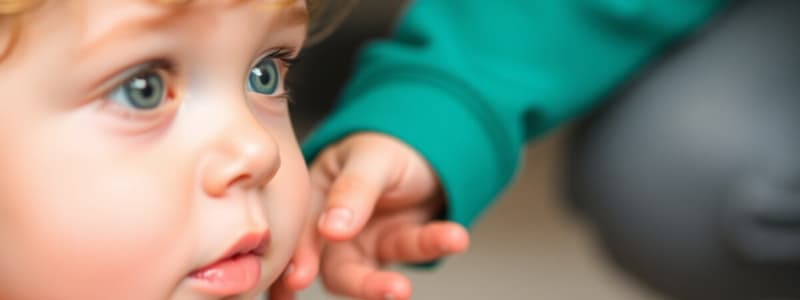Podcast
Questions and Answers
What was a significant finding of research regarding the role of parents?
What was a significant finding of research regarding the role of parents?
- Gender is more important than responsiveness.
- Fathers are not involved in childcare.
- Responsiveness is more important than gender. (correct)
- Mothers should always be the primary attachment figures.
Mothers automatically receive parental responsibility from birth in the UK.
Mothers automatically receive parental responsibility from birth in the UK.
True (A)
Who were the two researchers noted for their animal studies of attachment?
Who were the two researchers noted for their animal studies of attachment?
Konrad Lorenz and Harry Harlow
Imprinting occurs during a ______ period of development.
Imprinting occurs during a ______ period of development.
What behavior did Lorenz's geese chicks exhibit after imprinting on him?
What behavior did Lorenz's geese chicks exhibit after imprinting on him?
Animal studies are not relevant to human attachment theories.
Animal studies are not relevant to human attachment theories.
What type of species does imprinting mainly occur in?
What type of species does imprinting mainly occur in?
Match the researchers with their key contributions:
Match the researchers with their key contributions:
What does the Internal Working Model suggest about early childhood experiences?
What does the Internal Working Model suggest about early childhood experiences?
Bowlby posits that infants must form one special attachment that is central to their development.
Bowlby posits that infants must form one special attachment that is central to their development.
What did Schaffer and Emmerson conclude about infant attachments?
What did Schaffer and Emmerson conclude about infant attachments?
Bowlby's theory of attachment includes the concept of the __________, which is a crucial early relationship template.
Bowlby's theory of attachment includes the concept of the __________, which is a crucial early relationship template.
What is one alternative explanation for attachment mentioned in the evaluation of Bowlby’s theory?
What is one alternative explanation for attachment mentioned in the evaluation of Bowlby’s theory?
Feminists support Bowlby’s view that lifestyle choices of mothers can negatively impact children's attachment quality.
Feminists support Bowlby’s view that lifestyle choices of mothers can negatively impact children's attachment quality.
According to Bowlby, what could substantial time apart from a primary attachment figure risk?
According to Bowlby, what could substantial time apart from a primary attachment figure risk?
Match the following researchers to their contributions or findings regarding attachment:
Match the following researchers to their contributions or findings regarding attachment:
What was the main finding of Harlow's research on infant rhesus monkeys?
What was the main finding of Harlow's research on infant rhesus monkeys?
Harlow's research suggested that the feeding bond is crucial for developing attachment.
Harlow's research suggested that the feeding bond is crucial for developing attachment.
What type of environment did Harlow's cloth-covered mother provide?
What type of environment did Harlow's cloth-covered mother provide?
Harlow observed that motherless monkeys developed _____ abnormalities.
Harlow observed that motherless monkeys developed _____ abnormalities.
How long did Harlow study the infant monkeys?
How long did Harlow study the infant monkeys?
Match the following behaviors of motherless monkeys with their descriptions:
Match the following behaviors of motherless monkeys with their descriptions:
What happened to motherless monkeys that spent time with their peers before 3 months old?
What happened to motherless monkeys that spent time with their peers before 3 months old?
Harlow's findings support the view that human attachment is more related to _____ than to food.
Harlow's findings support the view that human attachment is more related to _____ than to food.
What is a major negative outcome for children raised in institutions?
What is a major negative outcome for children raised in institutions?
Children adopted before the age of six months are less likely to show disinhibited attachments.
Children adopted before the age of six months are less likely to show disinhibited attachments.
What is disinhibited attachment?
What is disinhibited attachment?
Deprivation dwarfism is mainly caused by a lack of _____ care.
Deprivation dwarfism is mainly caused by a lack of _____ care.
Match the following developmental outcomes with the ages at which children were adopted:
Match the following developmental outcomes with the ages at which children were adopted:
Which of the following best describes the main finding of the ERA study regarding Romanian orphans?
Which of the following best describes the main finding of the ERA study regarding Romanian orphans?
Institutionalised children generally show better physical development compared to children raised at home.
Institutionalised children generally show better physical development compared to children raised at home.
What does the term 'intellectual disability' refer to in the context of institutionalised children?
What does the term 'intellectual disability' refer to in the context of institutionalised children?
What procedure was used for the time sampling technique in the study?
What procedure was used for the time sampling technique in the study?
What percentage of total observations was the baby gazing at his mother?
What percentage of total observations was the baby gazing at his mother?
Which type of data best describes the data collected in this study?
Which type of data best describes the data collected in this study?
Overt observation means observing subjects without their knowledge.
Overt observation means observing subjects without their knowledge.
Explain how the researcher can collect both quantitative and qualitative data during this investigation.
Explain how the researcher can collect both quantitative and qualitative data during this investigation.
At 7 months, ___% of babies had formed multiple attachments.
At 7 months, ___% of babies had formed multiple attachments.
Match the ages of babies with the percentage of those who formed multiple attachments:
Match the ages of babies with the percentage of those who formed multiple attachments:
What term did Bowlby use to describe individuals who cannot experience guilt or strong emotions for others?
What term did Bowlby use to describe individuals who cannot experience guilt or strong emotions for others?
According to Bowlby's 44 Thieves Study, none of the juvenile thieves experienced maternal separation during their early years.
According to Bowlby's 44 Thieves Study, none of the juvenile thieves experienced maternal separation during their early years.
What percentage of young thieves in Bowlby's study showed 'affectionless psychopathy'?
What percentage of young thieves in Bowlby's study showed 'affectionless psychopathy'?
Bowlby’s theory suggests that separations longer than ______ months during the first five years can have lasting negative consequences.
Bowlby’s theory suggests that separations longer than ______ months during the first five years can have lasting negative consequences.
Match the following research studies to their findings:
Match the following research studies to their findings:
What is a limitation of Bowlby’s theory as suggested by Lewis's findings?
What is a limitation of Bowlby’s theory as suggested by Lewis's findings?
The control group in Bowlby's study consisted of individuals referred for stealing-related issues.
The control group in Bowlby's study consisted of individuals referred for stealing-related issues.
What might be associated with poor intellectual and emotional development according to Bowlby's theory?
What might be associated with poor intellectual and emotional development according to Bowlby's theory?
Flashcards
Harlow's Research
Harlow's Research
Study showing that monkey infants prefer comfort to food.
Wire Mother Experiment
Wire Mother Experiment
Experiment using two wire mothers to test attachment.
Contact Comfort
Contact Comfort
The comfort derived from physical contact with a caregiver.
Attachment Theory
Attachment Theory
Signup and view all the flashcards
Abnormal Development
Abnormal Development
Signup and view all the flashcards
Critical Period
Critical Period
Signup and view all the flashcards
Recovery with Peers
Recovery with Peers
Signup and view all the flashcards
Blowby's View
Blowby's View
Signup and view all the flashcards
Primary attachment figure
Primary attachment figure
Signup and view all the flashcards
Gender pay gap
Gender pay gap
Signup and view all the flashcards
Parental responsibility
Parental responsibility
Signup and view all the flashcards
Fathers for Justice
Fathers for Justice
Signup and view all the flashcards
Imprinting
Imprinting
Signup and view all the flashcards
Altricial species
Altricial species
Signup and view all the flashcards
Konrad Lorenz
Konrad Lorenz
Signup and view all the flashcards
Harry Harlow
Harry Harlow
Signup and view all the flashcards
Internal Working Model
Internal Working Model
Signup and view all the flashcards
Bowlby’s Monotropy Theory
Bowlby’s Monotropy Theory
Signup and view all the flashcards
Hazen & Shaver Research
Hazen & Shaver Research
Signup and view all the flashcards
Schaffer and Emmerson Findings
Schaffer and Emmerson Findings
Signup and view all the flashcards
Learning Theory of Attachment
Learning Theory of Attachment
Signup and view all the flashcards
Critical Period in Attachment
Critical Period in Attachment
Signup and view all the flashcards
Economic Consequences of Monotropy
Economic Consequences of Monotropy
Signup and view all the flashcards
Feminist Critique of Monotropy
Feminist Critique of Monotropy
Signup and view all the flashcards
Institutionalisation
Institutionalisation
Signup and view all the flashcards
Romanian Orphan Study
Romanian Orphan Study
Signup and view all the flashcards
Disinhibited Attachment
Disinhibited Attachment
Signup and view all the flashcards
Intellectual Development Damage
Intellectual Development Damage
Signup and view all the flashcards
Physical Underdevelopment
Physical Underdevelopment
Signup and view all the flashcards
Critical Age for Adoption
Critical Age for Adoption
Signup and view all the flashcards
Attachment Recovery
Attachment Recovery
Signup and view all the flashcards
Comparison with Controls
Comparison with Controls
Signup and view all the flashcards
Affectionless Psychopath
Affectionless Psychopath
Signup and view all the flashcards
Bowlby's 44 Thieves Study
Bowlby's 44 Thieves Study
Signup and view all the flashcards
Emotional Development
Emotional Development
Signup and view all the flashcards
Maternal Deprivation
Maternal Deprivation
Signup and view all the flashcards
Long-term Consequences
Long-term Consequences
Signup and view all the flashcards
Lewis's Counter Study
Lewis's Counter Study
Signup and view all the flashcards
Privation vs. Deprivation
Privation vs. Deprivation
Signup and view all the flashcards
Time Sampling Technique
Time Sampling Technique
Signup and view all the flashcards
Percentage of Gazing at Mother
Percentage of Gazing at Mother
Signup and view all the flashcards
Primary Data
Primary Data
Signup and view all the flashcards
Overt Observation
Overt Observation
Signup and view all the flashcards
Longitudinal Study
Longitudinal Study
Signup and view all the flashcards
Multiple Attachments
Multiple Attachments
Signup and view all the flashcards
Quantitative Data
Quantitative Data
Signup and view all the flashcards
Qualitative Data
Qualitative Data
Signup and view all the flashcards
Study Notes
Attachment
- Caregiver-infant interactions involve reciprocity and interactional synchrony
- Schaffer identified stages of attachment
- Multiple attachments exist, including the role of the father
- Animal studies of attachment include Lorenz (imprinting) and Harlow (contact comfort)
- Explanations of attachment include learning theory and Bowlby's monotropic theory
- Bowlby's theory includes a critical period and an internal working model
- Ainsworth's Strange Situation assesses attachment types (secure, insecure-avoidant, insecure-resistant)
- Cultural variations in attachment (e.g., Van Ijzendoorn) exist
- Bowlby's theory of maternal deprivation
- Romanian orphan studies: effects of institutionalisation
- Early attachment influences childhood and adult relationships, including the internal working model
Studying That Suits You
Use AI to generate personalized quizzes and flashcards to suit your learning preferences.




